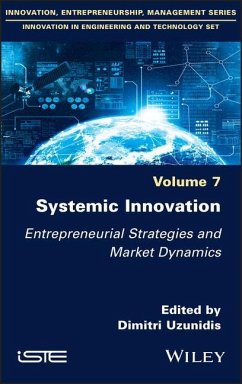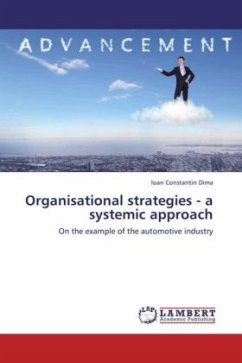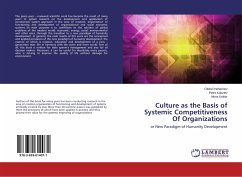Systemic Innovation
Entrepreneurial Strategies and Market Dynamics
Herausgeber: Uzunidis, Dimitri
Systemic Innovation
Entrepreneurial Strategies and Market Dynamics
Herausgeber: Uzunidis, Dimitri
- Gebundenes Buch
- Merkliste
- Auf die Merkliste
- Bewerten Bewerten
- Teilen
- Produkt teilen
- Produkterinnerung
- Produkterinnerung
INNOVATION IN ENGINEERING AND TECHNOLOGY SET Coordinated by Dimitri Uzunidis Systemic innovation is based on business networks and new business models in a global economy integrated by flows of knowledge, capital, and goods. The authors of this book consider the theory that innovations act as systems based on multi-actor interactions. Innovation is contextualized to demonstrate in what capacity a company or an entrepreneur can innovate. The book details the management of scientific, technical and cognitive resources, the relationships between R&D partners, the creativity and the rules that…mehr
Andere Kunden interessierten sich auch für
![Innovation in European Freight Transportation Innovation in European Freight Transportation]() Eva SavelsbergInnovation in European Freight Transportation77,99 €
Eva SavelsbergInnovation in European Freight Transportation77,99 €![Organisational strategies - a systemic approach Organisational strategies - a systemic approach]() Ioan Constantin DimaOrganisational strategies - a systemic approach40,99 €
Ioan Constantin DimaOrganisational strategies - a systemic approach40,99 €![Systemic Management for Intelligent Organizations Systemic Management for Intelligent Organizations]() Systemic Management for Intelligent Organizations77,99 €
Systemic Management for Intelligent Organizations77,99 €![Systemic Governance Systemic Governance]() Javier Carreón GuillénSystemic Governance37,99 €
Javier Carreón GuillénSystemic Governance37,99 €![Systemic Coaching Systemic Coaching]() Ichak K. AdizesSystemic Coaching28,99 €
Ichak K. AdizesSystemic Coaching28,99 €![Systemic Structure Behind Human Organizations Systemic Structure Behind Human Organizations]() Yi LinSystemic Structure Behind Human Organizations116,99 €
Yi LinSystemic Structure Behind Human Organizations116,99 €![Culture as the Basis of Systemic Competitiveness Of Organizations Culture as the Basis of Systemic Competitiveness Of Organizations]() Oleksii HaharinovCulture as the Basis of Systemic Competitiveness Of Organizations17,99 €
Oleksii HaharinovCulture as the Basis of Systemic Competitiveness Of Organizations17,99 €-
-
-
INNOVATION IN ENGINEERING AND TECHNOLOGY SET Coordinated by Dimitri Uzunidis Systemic innovation is based on business networks and new business models in a global economy integrated by flows of knowledge, capital, and goods. The authors of this book consider the theory that innovations act as systems based on multi-actor interactions. Innovation is contextualized to demonstrate in what capacity a company or an entrepreneur can innovate. The book details the management of scientific, technical and cognitive resources, the relationships between R&D partners, the creativity and the rules that allow a market and a company to innovate. This contextualization, associated with entrepreneurial strategy, leads to systemic innovation. This book analyzes some key sectors of the economy that are knowledge-intensive and rapidly changing: transport and communications, defense, information technology, artificial intelligence, and the environment.
Hinweis: Dieser Artikel kann nur an eine deutsche Lieferadresse ausgeliefert werden.
Hinweis: Dieser Artikel kann nur an eine deutsche Lieferadresse ausgeliefert werden.
Produktdetails
- Produktdetails
- Verlag: Wiley
- Seitenzahl: 288
- Erscheinungstermin: 3. November 2020
- Englisch
- Abmessung: 242mm x 165mm x 22mm
- Gewicht: 545g
- ISBN-13: 9781786306586
- ISBN-10: 1786306581
- Artikelnr.: 60069074
- Herstellerkennzeichnung
- Libri GmbH
- Europaallee 1
- 36244 Bad Hersfeld
- gpsr@libri.de
- Verlag: Wiley
- Seitenzahl: 288
- Erscheinungstermin: 3. November 2020
- Englisch
- Abmessung: 242mm x 165mm x 22mm
- Gewicht: 545g
- ISBN-13: 9781786306586
- ISBN-10: 1786306581
- Artikelnr.: 60069074
- Herstellerkennzeichnung
- Libri GmbH
- Europaallee 1
- 36244 Bad Hersfeld
- gpsr@libri.de
Dimitri Uzunidis is a Professor of Political Economy and the Honorary President of the Innovation Research Network in France. He has directed and edited several journals and collections on the study of innovation and paradigmatic change. As a specialist in change, he provides expertise for various international organizations.
General Introduction: Systemic Innovations and Transformation of
Organizational Models xi
Dimitri UZUNIDIS
Chapter 1. Enterprise Through the Lens of Agility, Creativity and
Monitoring Method Combinations 1
Stéphane GORIA
1.1. Introduction 1
1.2. Agility and its manifesto 2
1.3. Agility and the design process 4
1.4. Agility and creativity 7
1.5. Agility and decision-making 9
1.6. Innovation-oriented agile monitoring 12
1.7. Conclusion 14
1.8. References 15
Chapter 2. Science Fiction: A Strategic Approach for Innovative
Organizations 19
Thomas MICHAUD
2.1. Introduction 19
2.2. Science fiction, a futuristic fantasy for engineers and innovators 21
2.2.1. The scientific imagination behind major discoveries 21
2.2.2. Examples: virtual reality and the conquest of Mars 22
2.3. Science fiction and creativity: new approaches 25
2.3.1. Design fiction, a method for stimulating creativity 25
2.3.2. Science fiction prototyping 27
2.4. Towards a theory of technotypes 27
2.4.1. Utopian technologies and the technological utopianism of American
culture 28
2.4.2. Technotypes, structures of the technical imaginary 31
2.5. Conclusion 33
2.6. References 34
Chapter 3. The Management of Inventive Knowledge: From Inventive
Intellectual Corpus to Innovation 37
Pierre SAULAIS and Jean-Louis ERMINE
3.1. Introduction 37
3.2. From knowledge capital to knowledge management 38
3.3. Knowledge-based knowledge management 40
3.4. The knowledge capital and the inventive intellectual corpus 42
3.4.1. Knowledge capital 42
3.4.2. The inventive intellectual corpus and the dematerialized knowledge
object 43
3.4.3. The inventive intellectual corpus at the heart of innovation 43
3.5. The virtuous cycle of knowledge management 45
3.6. The MASK method 46
3.6.1. MASK II: Analysis of knowledge capital 47
3.6.2. MASK I: Capitalization of knowledge capital 48
3.6.3. MASK III: Sharing the knowledge capital 48
3.6.4. MASK IV: Evolution of the knowledge capital 49
3.7. Illustrations with real cases from "economic reality" 50
3.7.1. Strategic analysis and capitalization: the case of IRSN 50
3.7.2. Transfer: the case of Sonatrach 53
3.7.3. Innovation: the case of ONERA 58
3.8. Conclusion 62
3.9. References 63
Chapter 4. Evolution of Firms Trajectories and Innovation: Knowledge
Capital and Financial Opportunities 67
Blandine LAPERCHE
4.1. Introduction 67
4.2. Technological and firms trajectories 68
4.2.1. Technological paradigms and trajectories: first definitions 68
4.2.2. Paradigms, regimes and trajectories: empirical studies 69
4.2.3. The firm's trajectory or evolutionary path 71
4.3. The formation of trajectories: knowledge capital and financial
opportunities 73
4.3.1. Dynamic capabilities and knowledge capital 73
4.3.2. The collective dimension of trajectories and its consequences 75
4.3.3. Financial opportunities, firm evolution and technical change 77
4.4. Conclusion 79
4.5. References 79
Chapter 5. From Shared Inventions to Competitive Innovations: Networks and
Enterprise Automation Strategies 85
Michel VIGEZZI and Dimitri UZUNIDIS
5.1. Introduction 85
5.2. Applications of recent concepts in automation: social dynamics, shared
inventions and competitive innovations 87
5.2.1. Shared inventions... 87
5.2.2. Competitive innovations 90
5.2.3. Social dynamics 93
5.2.4. What coherences are there between shared inventions and competitive
innovations? 94
5.3. "Phase 1" automation: machine inventions, networks of inventors and
jobs 94
5.3.1. The discoveries of these shared inventions 95
5.3.2. Networks and shared inventions 96
5.4. Phase 2 automation: innovations and sets of machines, networks and
work dimensions 100
5.4.1. Automation and changes in work 100
5.5. Conclusion 105
5.6. References 106
Chapter 6. Technologies and Inter-industrial Collaborations: A Patent
Analysis 111
Didier LEBERT and François-Xavier MEUNIER
6.1. Introduction 111
6.2. Method: the co-patent multigraph 112
6.3. Data and descriptive statistics 116
6.4. A structural look at R&D cooperation: results and discussion 124
6.5. Conclusion 133
6.6. Appendix 135
6.7. References 141
Chapter 7. Technological Change and Environmental Transition: Lessons from
the Case of the Automobile 143
Smaïl AÏT-EL-HADJ
7.1. Introduction 143
7.2. Encountering a major technological limit: the environmental limitation
144
7.2.1. Technological system dynamics 144
7.2.2. Nature and forms of the environmental limit 145
7.3. The irruption of the environmental limit as a determining/dominant
factor in technological change: the case of automotive system technology
146
7.3.1. The environmental limit of the automotive system 147
7.3.2. Corrective action of a social, fiscal and regulatory nature 149
7.3.3. Forms and stages of technological change in road transport 153
7.4. The environmental limit as a factor of a major technological change
157
7.4.1. Nature and actions of environmental limits 157
7.4.2. Generation of a new change regime 158
7.5. Conclusion 160
7.6. References 161
Chapter 8. The Transformation of Defense Innovation Systems: Knowledge
Bases, Disruptive Technologies and Operational Capabilities 163
Pierre BARBAROUX
8.1. Introduction 163
8.2. The evolution of knowledge bases: duality and complexity 165
8.2.1. Dual-use technology 165
8.2.2. Knowledge complexity and scientific intensity 168
8.3. The disruptive impact of technology: artificial intelligence and
autonomous systems 169
8.3.1. AI: definitions and sources of legitimacy 170
8.4. The transformation of military capabilities: network-centric warfare
and multi-domain C2 174
8.4.1. First step: network-centric warfare (NCW) 174
8.4.2. Second step: multi-domain command and control (MDC2) 176
8.5. Conclusion 178
8.6. References 178
Chapter 9. Nanotechnologies and Business Intelligence: Challenges of
Information Valorization and Knowledge Creation 183
Jean-Louis MONINO
9.1. Introduction 183
9.2. Overview of nanotechnology and its economic and technical potential.
184
9.2.1. Understanding nanotechnology 185
9.2.2. The challenges of nanotechnology 188
9.2.3. The limits of nanotechnology 190
9.3. Business intelligence 192
9.3.1. History and definition of business intelligence 192
9.3.2. Information at the heart of business intelligence 193
9.4. Business intelligence and nanotechnology 195
9.4.1. Examples: quantum computers, RFID chips 196
9.4.2. Nanotechnology in industry 197
9.4.3. What are the limits and stakes? 199
9.5. Conclusion 200
9.6. References 201
Chapter 10. When Innovation Innovates: How Artificial Intelligence
Challenges the Patent System 205
Marc BAUDRY and Beatrice DUMONT
10.1. Introduction 205
10.2. Definitions and evolution over time of AI technologies 207
10.3. The difficult issue of the patentability of AI 209
10.3.1. The patent subject-matter eligibility of AI technologies 209
10.3.2. Who should be listed as the inventor? 213
10.3.3. Liability for patent infringement by AI 215
10.4. AI patents in light of economic theory 216
10.4.1. The rationale for granting patents 216
10.4.2. AI patents, incremental inventions and legal implications 218
10.5. Conclusion 220
10.6. References 221
Chapter 11. Conflicting Standards and Innovation in Energy Transition 223
Stéphane CALLENS
11.1. Introduction: a change of culture 223
11.2. Green innovations and standardization 225
11.2.1. Regulatory quality defined on the basis of a relationship between
standards and innovation 228
11.2.2. Another multi-level management: sovereignty and innovation 230
11.3. The conflict of standards: globalization, sovereignty and democracy
232
11.3.1. Acting solely through taxation? 232
11.3.2. Acting solely through local and regional authorities? 234
11.3.3. The conflict of standards: Europe and the United States 235
11.4. The energy transition: a natural experiment 240
11.5. Conclusion 241
11.6. References 242
List of Authors 245
Index 247
Organizational Models xi
Dimitri UZUNIDIS
Chapter 1. Enterprise Through the Lens of Agility, Creativity and
Monitoring Method Combinations 1
Stéphane GORIA
1.1. Introduction 1
1.2. Agility and its manifesto 2
1.3. Agility and the design process 4
1.4. Agility and creativity 7
1.5. Agility and decision-making 9
1.6. Innovation-oriented agile monitoring 12
1.7. Conclusion 14
1.8. References 15
Chapter 2. Science Fiction: A Strategic Approach for Innovative
Organizations 19
Thomas MICHAUD
2.1. Introduction 19
2.2. Science fiction, a futuristic fantasy for engineers and innovators 21
2.2.1. The scientific imagination behind major discoveries 21
2.2.2. Examples: virtual reality and the conquest of Mars 22
2.3. Science fiction and creativity: new approaches 25
2.3.1. Design fiction, a method for stimulating creativity 25
2.3.2. Science fiction prototyping 27
2.4. Towards a theory of technotypes 27
2.4.1. Utopian technologies and the technological utopianism of American
culture 28
2.4.2. Technotypes, structures of the technical imaginary 31
2.5. Conclusion 33
2.6. References 34
Chapter 3. The Management of Inventive Knowledge: From Inventive
Intellectual Corpus to Innovation 37
Pierre SAULAIS and Jean-Louis ERMINE
3.1. Introduction 37
3.2. From knowledge capital to knowledge management 38
3.3. Knowledge-based knowledge management 40
3.4. The knowledge capital and the inventive intellectual corpus 42
3.4.1. Knowledge capital 42
3.4.2. The inventive intellectual corpus and the dematerialized knowledge
object 43
3.4.3. The inventive intellectual corpus at the heart of innovation 43
3.5. The virtuous cycle of knowledge management 45
3.6. The MASK method 46
3.6.1. MASK II: Analysis of knowledge capital 47
3.6.2. MASK I: Capitalization of knowledge capital 48
3.6.3. MASK III: Sharing the knowledge capital 48
3.6.4. MASK IV: Evolution of the knowledge capital 49
3.7. Illustrations with real cases from "economic reality" 50
3.7.1. Strategic analysis and capitalization: the case of IRSN 50
3.7.2. Transfer: the case of Sonatrach 53
3.7.3. Innovation: the case of ONERA 58
3.8. Conclusion 62
3.9. References 63
Chapter 4. Evolution of Firms Trajectories and Innovation: Knowledge
Capital and Financial Opportunities 67
Blandine LAPERCHE
4.1. Introduction 67
4.2. Technological and firms trajectories 68
4.2.1. Technological paradigms and trajectories: first definitions 68
4.2.2. Paradigms, regimes and trajectories: empirical studies 69
4.2.3. The firm's trajectory or evolutionary path 71
4.3. The formation of trajectories: knowledge capital and financial
opportunities 73
4.3.1. Dynamic capabilities and knowledge capital 73
4.3.2. The collective dimension of trajectories and its consequences 75
4.3.3. Financial opportunities, firm evolution and technical change 77
4.4. Conclusion 79
4.5. References 79
Chapter 5. From Shared Inventions to Competitive Innovations: Networks and
Enterprise Automation Strategies 85
Michel VIGEZZI and Dimitri UZUNIDIS
5.1. Introduction 85
5.2. Applications of recent concepts in automation: social dynamics, shared
inventions and competitive innovations 87
5.2.1. Shared inventions... 87
5.2.2. Competitive innovations 90
5.2.3. Social dynamics 93
5.2.4. What coherences are there between shared inventions and competitive
innovations? 94
5.3. "Phase 1" automation: machine inventions, networks of inventors and
jobs 94
5.3.1. The discoveries of these shared inventions 95
5.3.2. Networks and shared inventions 96
5.4. Phase 2 automation: innovations and sets of machines, networks and
work dimensions 100
5.4.1. Automation and changes in work 100
5.5. Conclusion 105
5.6. References 106
Chapter 6. Technologies and Inter-industrial Collaborations: A Patent
Analysis 111
Didier LEBERT and François-Xavier MEUNIER
6.1. Introduction 111
6.2. Method: the co-patent multigraph 112
6.3. Data and descriptive statistics 116
6.4. A structural look at R&D cooperation: results and discussion 124
6.5. Conclusion 133
6.6. Appendix 135
6.7. References 141
Chapter 7. Technological Change and Environmental Transition: Lessons from
the Case of the Automobile 143
Smaïl AÏT-EL-HADJ
7.1. Introduction 143
7.2. Encountering a major technological limit: the environmental limitation
144
7.2.1. Technological system dynamics 144
7.2.2. Nature and forms of the environmental limit 145
7.3. The irruption of the environmental limit as a determining/dominant
factor in technological change: the case of automotive system technology
146
7.3.1. The environmental limit of the automotive system 147
7.3.2. Corrective action of a social, fiscal and regulatory nature 149
7.3.3. Forms and stages of technological change in road transport 153
7.4. The environmental limit as a factor of a major technological change
157
7.4.1. Nature and actions of environmental limits 157
7.4.2. Generation of a new change regime 158
7.5. Conclusion 160
7.6. References 161
Chapter 8. The Transformation of Defense Innovation Systems: Knowledge
Bases, Disruptive Technologies and Operational Capabilities 163
Pierre BARBAROUX
8.1. Introduction 163
8.2. The evolution of knowledge bases: duality and complexity 165
8.2.1. Dual-use technology 165
8.2.2. Knowledge complexity and scientific intensity 168
8.3. The disruptive impact of technology: artificial intelligence and
autonomous systems 169
8.3.1. AI: definitions and sources of legitimacy 170
8.4. The transformation of military capabilities: network-centric warfare
and multi-domain C2 174
8.4.1. First step: network-centric warfare (NCW) 174
8.4.2. Second step: multi-domain command and control (MDC2) 176
8.5. Conclusion 178
8.6. References 178
Chapter 9. Nanotechnologies and Business Intelligence: Challenges of
Information Valorization and Knowledge Creation 183
Jean-Louis MONINO
9.1. Introduction 183
9.2. Overview of nanotechnology and its economic and technical potential.
184
9.2.1. Understanding nanotechnology 185
9.2.2. The challenges of nanotechnology 188
9.2.3. The limits of nanotechnology 190
9.3. Business intelligence 192
9.3.1. History and definition of business intelligence 192
9.3.2. Information at the heart of business intelligence 193
9.4. Business intelligence and nanotechnology 195
9.4.1. Examples: quantum computers, RFID chips 196
9.4.2. Nanotechnology in industry 197
9.4.3. What are the limits and stakes? 199
9.5. Conclusion 200
9.6. References 201
Chapter 10. When Innovation Innovates: How Artificial Intelligence
Challenges the Patent System 205
Marc BAUDRY and Beatrice DUMONT
10.1. Introduction 205
10.2. Definitions and evolution over time of AI technologies 207
10.3. The difficult issue of the patentability of AI 209
10.3.1. The patent subject-matter eligibility of AI technologies 209
10.3.2. Who should be listed as the inventor? 213
10.3.3. Liability for patent infringement by AI 215
10.4. AI patents in light of economic theory 216
10.4.1. The rationale for granting patents 216
10.4.2. AI patents, incremental inventions and legal implications 218
10.5. Conclusion 220
10.6. References 221
Chapter 11. Conflicting Standards and Innovation in Energy Transition 223
Stéphane CALLENS
11.1. Introduction: a change of culture 223
11.2. Green innovations and standardization 225
11.2.1. Regulatory quality defined on the basis of a relationship between
standards and innovation 228
11.2.2. Another multi-level management: sovereignty and innovation 230
11.3. The conflict of standards: globalization, sovereignty and democracy
232
11.3.1. Acting solely through taxation? 232
11.3.2. Acting solely through local and regional authorities? 234
11.3.3. The conflict of standards: Europe and the United States 235
11.4. The energy transition: a natural experiment 240
11.5. Conclusion 241
11.6. References 242
List of Authors 245
Index 247
General Introduction: Systemic Innovations and Transformation of
Organizational Models xi
Dimitri UZUNIDIS
Chapter 1. Enterprise Through the Lens of Agility, Creativity and
Monitoring Method Combinations 1
Stéphane GORIA
1.1. Introduction 1
1.2. Agility and its manifesto 2
1.3. Agility and the design process 4
1.4. Agility and creativity 7
1.5. Agility and decision-making 9
1.6. Innovation-oriented agile monitoring 12
1.7. Conclusion 14
1.8. References 15
Chapter 2. Science Fiction: A Strategic Approach for Innovative
Organizations 19
Thomas MICHAUD
2.1. Introduction 19
2.2. Science fiction, a futuristic fantasy for engineers and innovators 21
2.2.1. The scientific imagination behind major discoveries 21
2.2.2. Examples: virtual reality and the conquest of Mars 22
2.3. Science fiction and creativity: new approaches 25
2.3.1. Design fiction, a method for stimulating creativity 25
2.3.2. Science fiction prototyping 27
2.4. Towards a theory of technotypes 27
2.4.1. Utopian technologies and the technological utopianism of American
culture 28
2.4.2. Technotypes, structures of the technical imaginary 31
2.5. Conclusion 33
2.6. References 34
Chapter 3. The Management of Inventive Knowledge: From Inventive
Intellectual Corpus to Innovation 37
Pierre SAULAIS and Jean-Louis ERMINE
3.1. Introduction 37
3.2. From knowledge capital to knowledge management 38
3.3. Knowledge-based knowledge management 40
3.4. The knowledge capital and the inventive intellectual corpus 42
3.4.1. Knowledge capital 42
3.4.2. The inventive intellectual corpus and the dematerialized knowledge
object 43
3.4.3. The inventive intellectual corpus at the heart of innovation 43
3.5. The virtuous cycle of knowledge management 45
3.6. The MASK method 46
3.6.1. MASK II: Analysis of knowledge capital 47
3.6.2. MASK I: Capitalization of knowledge capital 48
3.6.3. MASK III: Sharing the knowledge capital 48
3.6.4. MASK IV: Evolution of the knowledge capital 49
3.7. Illustrations with real cases from "economic reality" 50
3.7.1. Strategic analysis and capitalization: the case of IRSN 50
3.7.2. Transfer: the case of Sonatrach 53
3.7.3. Innovation: the case of ONERA 58
3.8. Conclusion 62
3.9. References 63
Chapter 4. Evolution of Firms Trajectories and Innovation: Knowledge
Capital and Financial Opportunities 67
Blandine LAPERCHE
4.1. Introduction 67
4.2. Technological and firms trajectories 68
4.2.1. Technological paradigms and trajectories: first definitions 68
4.2.2. Paradigms, regimes and trajectories: empirical studies 69
4.2.3. The firm's trajectory or evolutionary path 71
4.3. The formation of trajectories: knowledge capital and financial
opportunities 73
4.3.1. Dynamic capabilities and knowledge capital 73
4.3.2. The collective dimension of trajectories and its consequences 75
4.3.3. Financial opportunities, firm evolution and technical change 77
4.4. Conclusion 79
4.5. References 79
Chapter 5. From Shared Inventions to Competitive Innovations: Networks and
Enterprise Automation Strategies 85
Michel VIGEZZI and Dimitri UZUNIDIS
5.1. Introduction 85
5.2. Applications of recent concepts in automation: social dynamics, shared
inventions and competitive innovations 87
5.2.1. Shared inventions... 87
5.2.2. Competitive innovations 90
5.2.3. Social dynamics 93
5.2.4. What coherences are there between shared inventions and competitive
innovations? 94
5.3. "Phase 1" automation: machine inventions, networks of inventors and
jobs 94
5.3.1. The discoveries of these shared inventions 95
5.3.2. Networks and shared inventions 96
5.4. Phase 2 automation: innovations and sets of machines, networks and
work dimensions 100
5.4.1. Automation and changes in work 100
5.5. Conclusion 105
5.6. References 106
Chapter 6. Technologies and Inter-industrial Collaborations: A Patent
Analysis 111
Didier LEBERT and François-Xavier MEUNIER
6.1. Introduction 111
6.2. Method: the co-patent multigraph 112
6.3. Data and descriptive statistics 116
6.4. A structural look at R&D cooperation: results and discussion 124
6.5. Conclusion 133
6.6. Appendix 135
6.7. References 141
Chapter 7. Technological Change and Environmental Transition: Lessons from
the Case of the Automobile 143
Smaïl AÏT-EL-HADJ
7.1. Introduction 143
7.2. Encountering a major technological limit: the environmental limitation
144
7.2.1. Technological system dynamics 144
7.2.2. Nature and forms of the environmental limit 145
7.3. The irruption of the environmental limit as a determining/dominant
factor in technological change: the case of automotive system technology
146
7.3.1. The environmental limit of the automotive system 147
7.3.2. Corrective action of a social, fiscal and regulatory nature 149
7.3.3. Forms and stages of technological change in road transport 153
7.4. The environmental limit as a factor of a major technological change
157
7.4.1. Nature and actions of environmental limits 157
7.4.2. Generation of a new change regime 158
7.5. Conclusion 160
7.6. References 161
Chapter 8. The Transformation of Defense Innovation Systems: Knowledge
Bases, Disruptive Technologies and Operational Capabilities 163
Pierre BARBAROUX
8.1. Introduction 163
8.2. The evolution of knowledge bases: duality and complexity 165
8.2.1. Dual-use technology 165
8.2.2. Knowledge complexity and scientific intensity 168
8.3. The disruptive impact of technology: artificial intelligence and
autonomous systems 169
8.3.1. AI: definitions and sources of legitimacy 170
8.4. The transformation of military capabilities: network-centric warfare
and multi-domain C2 174
8.4.1. First step: network-centric warfare (NCW) 174
8.4.2. Second step: multi-domain command and control (MDC2) 176
8.5. Conclusion 178
8.6. References 178
Chapter 9. Nanotechnologies and Business Intelligence: Challenges of
Information Valorization and Knowledge Creation 183
Jean-Louis MONINO
9.1. Introduction 183
9.2. Overview of nanotechnology and its economic and technical potential.
184
9.2.1. Understanding nanotechnology 185
9.2.2. The challenges of nanotechnology 188
9.2.3. The limits of nanotechnology 190
9.3. Business intelligence 192
9.3.1. History and definition of business intelligence 192
9.3.2. Information at the heart of business intelligence 193
9.4. Business intelligence and nanotechnology 195
9.4.1. Examples: quantum computers, RFID chips 196
9.4.2. Nanotechnology in industry 197
9.4.3. What are the limits and stakes? 199
9.5. Conclusion 200
9.6. References 201
Chapter 10. When Innovation Innovates: How Artificial Intelligence
Challenges the Patent System 205
Marc BAUDRY and Beatrice DUMONT
10.1. Introduction 205
10.2. Definitions and evolution over time of AI technologies 207
10.3. The difficult issue of the patentability of AI 209
10.3.1. The patent subject-matter eligibility of AI technologies 209
10.3.2. Who should be listed as the inventor? 213
10.3.3. Liability for patent infringement by AI 215
10.4. AI patents in light of economic theory 216
10.4.1. The rationale for granting patents 216
10.4.2. AI patents, incremental inventions and legal implications 218
10.5. Conclusion 220
10.6. References 221
Chapter 11. Conflicting Standards and Innovation in Energy Transition 223
Stéphane CALLENS
11.1. Introduction: a change of culture 223
11.2. Green innovations and standardization 225
11.2.1. Regulatory quality defined on the basis of a relationship between
standards and innovation 228
11.2.2. Another multi-level management: sovereignty and innovation 230
11.3. The conflict of standards: globalization, sovereignty and democracy
232
11.3.1. Acting solely through taxation? 232
11.3.2. Acting solely through local and regional authorities? 234
11.3.3. The conflict of standards: Europe and the United States 235
11.4. The energy transition: a natural experiment 240
11.5. Conclusion 241
11.6. References 242
List of Authors 245
Index 247
Organizational Models xi
Dimitri UZUNIDIS
Chapter 1. Enterprise Through the Lens of Agility, Creativity and
Monitoring Method Combinations 1
Stéphane GORIA
1.1. Introduction 1
1.2. Agility and its manifesto 2
1.3. Agility and the design process 4
1.4. Agility and creativity 7
1.5. Agility and decision-making 9
1.6. Innovation-oriented agile monitoring 12
1.7. Conclusion 14
1.8. References 15
Chapter 2. Science Fiction: A Strategic Approach for Innovative
Organizations 19
Thomas MICHAUD
2.1. Introduction 19
2.2. Science fiction, a futuristic fantasy for engineers and innovators 21
2.2.1. The scientific imagination behind major discoveries 21
2.2.2. Examples: virtual reality and the conquest of Mars 22
2.3. Science fiction and creativity: new approaches 25
2.3.1. Design fiction, a method for stimulating creativity 25
2.3.2. Science fiction prototyping 27
2.4. Towards a theory of technotypes 27
2.4.1. Utopian technologies and the technological utopianism of American
culture 28
2.4.2. Technotypes, structures of the technical imaginary 31
2.5. Conclusion 33
2.6. References 34
Chapter 3. The Management of Inventive Knowledge: From Inventive
Intellectual Corpus to Innovation 37
Pierre SAULAIS and Jean-Louis ERMINE
3.1. Introduction 37
3.2. From knowledge capital to knowledge management 38
3.3. Knowledge-based knowledge management 40
3.4. The knowledge capital and the inventive intellectual corpus 42
3.4.1. Knowledge capital 42
3.4.2. The inventive intellectual corpus and the dematerialized knowledge
object 43
3.4.3. The inventive intellectual corpus at the heart of innovation 43
3.5. The virtuous cycle of knowledge management 45
3.6. The MASK method 46
3.6.1. MASK II: Analysis of knowledge capital 47
3.6.2. MASK I: Capitalization of knowledge capital 48
3.6.3. MASK III: Sharing the knowledge capital 48
3.6.4. MASK IV: Evolution of the knowledge capital 49
3.7. Illustrations with real cases from "economic reality" 50
3.7.1. Strategic analysis and capitalization: the case of IRSN 50
3.7.2. Transfer: the case of Sonatrach 53
3.7.3. Innovation: the case of ONERA 58
3.8. Conclusion 62
3.9. References 63
Chapter 4. Evolution of Firms Trajectories and Innovation: Knowledge
Capital and Financial Opportunities 67
Blandine LAPERCHE
4.1. Introduction 67
4.2. Technological and firms trajectories 68
4.2.1. Technological paradigms and trajectories: first definitions 68
4.2.2. Paradigms, regimes and trajectories: empirical studies 69
4.2.3. The firm's trajectory or evolutionary path 71
4.3. The formation of trajectories: knowledge capital and financial
opportunities 73
4.3.1. Dynamic capabilities and knowledge capital 73
4.3.2. The collective dimension of trajectories and its consequences 75
4.3.3. Financial opportunities, firm evolution and technical change 77
4.4. Conclusion 79
4.5. References 79
Chapter 5. From Shared Inventions to Competitive Innovations: Networks and
Enterprise Automation Strategies 85
Michel VIGEZZI and Dimitri UZUNIDIS
5.1. Introduction 85
5.2. Applications of recent concepts in automation: social dynamics, shared
inventions and competitive innovations 87
5.2.1. Shared inventions... 87
5.2.2. Competitive innovations 90
5.2.3. Social dynamics 93
5.2.4. What coherences are there between shared inventions and competitive
innovations? 94
5.3. "Phase 1" automation: machine inventions, networks of inventors and
jobs 94
5.3.1. The discoveries of these shared inventions 95
5.3.2. Networks and shared inventions 96
5.4. Phase 2 automation: innovations and sets of machines, networks and
work dimensions 100
5.4.1. Automation and changes in work 100
5.5. Conclusion 105
5.6. References 106
Chapter 6. Technologies and Inter-industrial Collaborations: A Patent
Analysis 111
Didier LEBERT and François-Xavier MEUNIER
6.1. Introduction 111
6.2. Method: the co-patent multigraph 112
6.3. Data and descriptive statistics 116
6.4. A structural look at R&D cooperation: results and discussion 124
6.5. Conclusion 133
6.6. Appendix 135
6.7. References 141
Chapter 7. Technological Change and Environmental Transition: Lessons from
the Case of the Automobile 143
Smaïl AÏT-EL-HADJ
7.1. Introduction 143
7.2. Encountering a major technological limit: the environmental limitation
144
7.2.1. Technological system dynamics 144
7.2.2. Nature and forms of the environmental limit 145
7.3. The irruption of the environmental limit as a determining/dominant
factor in technological change: the case of automotive system technology
146
7.3.1. The environmental limit of the automotive system 147
7.3.2. Corrective action of a social, fiscal and regulatory nature 149
7.3.3. Forms and stages of technological change in road transport 153
7.4. The environmental limit as a factor of a major technological change
157
7.4.1. Nature and actions of environmental limits 157
7.4.2. Generation of a new change regime 158
7.5. Conclusion 160
7.6. References 161
Chapter 8. The Transformation of Defense Innovation Systems: Knowledge
Bases, Disruptive Technologies and Operational Capabilities 163
Pierre BARBAROUX
8.1. Introduction 163
8.2. The evolution of knowledge bases: duality and complexity 165
8.2.1. Dual-use technology 165
8.2.2. Knowledge complexity and scientific intensity 168
8.3. The disruptive impact of technology: artificial intelligence and
autonomous systems 169
8.3.1. AI: definitions and sources of legitimacy 170
8.4. The transformation of military capabilities: network-centric warfare
and multi-domain C2 174
8.4.1. First step: network-centric warfare (NCW) 174
8.4.2. Second step: multi-domain command and control (MDC2) 176
8.5. Conclusion 178
8.6. References 178
Chapter 9. Nanotechnologies and Business Intelligence: Challenges of
Information Valorization and Knowledge Creation 183
Jean-Louis MONINO
9.1. Introduction 183
9.2. Overview of nanotechnology and its economic and technical potential.
184
9.2.1. Understanding nanotechnology 185
9.2.2. The challenges of nanotechnology 188
9.2.3. The limits of nanotechnology 190
9.3. Business intelligence 192
9.3.1. History and definition of business intelligence 192
9.3.2. Information at the heart of business intelligence 193
9.4. Business intelligence and nanotechnology 195
9.4.1. Examples: quantum computers, RFID chips 196
9.4.2. Nanotechnology in industry 197
9.4.3. What are the limits and stakes? 199
9.5. Conclusion 200
9.6. References 201
Chapter 10. When Innovation Innovates: How Artificial Intelligence
Challenges the Patent System 205
Marc BAUDRY and Beatrice DUMONT
10.1. Introduction 205
10.2. Definitions and evolution over time of AI technologies 207
10.3. The difficult issue of the patentability of AI 209
10.3.1. The patent subject-matter eligibility of AI technologies 209
10.3.2. Who should be listed as the inventor? 213
10.3.3. Liability for patent infringement by AI 215
10.4. AI patents in light of economic theory 216
10.4.1. The rationale for granting patents 216
10.4.2. AI patents, incremental inventions and legal implications 218
10.5. Conclusion 220
10.6. References 221
Chapter 11. Conflicting Standards and Innovation in Energy Transition 223
Stéphane CALLENS
11.1. Introduction: a change of culture 223
11.2. Green innovations and standardization 225
11.2.1. Regulatory quality defined on the basis of a relationship between
standards and innovation 228
11.2.2. Another multi-level management: sovereignty and innovation 230
11.3. The conflict of standards: globalization, sovereignty and democracy
232
11.3.1. Acting solely through taxation? 232
11.3.2. Acting solely through local and regional authorities? 234
11.3.3. The conflict of standards: Europe and the United States 235
11.4. The energy transition: a natural experiment 240
11.5. Conclusion 241
11.6. References 242
List of Authors 245
Index 247








